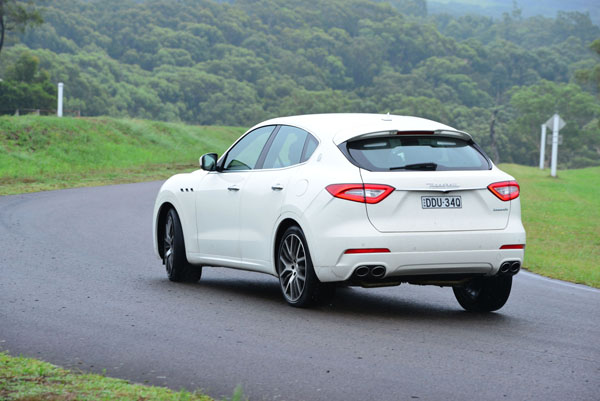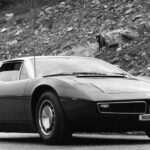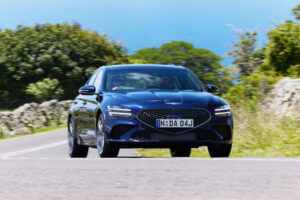 Prestige car buyers are embracing SUVs in a big way. Latest to join the lineup is Italian Maserati with a model tagged Levante.
Prestige car buyers are embracing SUVs in a big way. Latest to join the lineup is Italian Maserati with a model tagged Levante.
Note, however, that Australia’s Maserati chief, Glen Sealey, regards Levante not as a ‘prestige’ vehicle, but as an ‘exclusive’ one. His reasoning is that the big name Germans and Brits are dabbling in so many low-cost areas, and consequently have lost some of their prestige shine.
Sealey says Maserati Levante can step into the gap the others are leaving.
Those looking for Italian stye and panache as opposed to German or British staidness have already put down serious deposits on Maserati Levantes. Indeed some have taken delivery of theirs as the first batch has just come off the ships. Among that batch were three Levantes we have just road, and off-road, tested.
You read correctly, we’ve done some off-road testing in a prestige (err … exclusive) upmarket European SUV. More about that in a moment.
With prices starting at just $139,900 for the model simply called Levante, and going through to $159,900 for the Levante Sport and Levante Luxury. Dealer and government charges have to be added, but you might be able get one in your driveway for a little over $150,000.
Mind you, once you’re into the Maserati customisation areas of the showroom and start to tick the options boxes the price can head for the heavens. Your call, but there are plenty of interesting items in there, particularly for interior customisation.
It’s difficult to make an SUV look sporty, but the guys and gals in the Maserati styling studios have done excellent work. Cues to the Maserati sports sedan and coupe shapes are the very large grille with the central trident; the triple side vents on the front guards, which are even bolder than those in the Ghibli and Quattroporte; the bold rear haunches; and the shape of the taillights, with the chromed spear between them.
Contrary to public opinion the famed Pininfarina studio wasn’t involved, Levante is all in-house Maserati. It’s built in Turin, Italy as well and all of the Italian teams involved are extremely proud of that fact.
Inside, the first thing you see is the very Maserati analog-look clock sitting proudly at the top of the dashboard. The instruments are large and clear and in the Italian manner are very definitely aimed at the driver’s vision.
There’s an 8.4-inch central touchscreen to control many vehicle and infotainment functions, including Apple Carplay, Android Auto and Siri voice recognition.
Levante’s rear seats are set up for two, with a smaller third seat between them, not only is that seat narrow but legroom is reduced by the protruding rear section of the centre console. Legroom in the rear is good, but headroom is restricted if a sunroof is fitted.
The sporty slope of the tail limits Levante’s usefulness as a cargo carried. Though the load area is long and wide the top of the tailgate sits almost directly over the rear seatback. Large boxes probably won’t fit.
A sensible feature is that the push-button to close the tailgate is low down in the interior side panel, not in the tailgate itself where it can be hard to reach.
The diesel engine is a 3.0-litre V6 with twin turbochargers. It has outputs of 202 kW of power, and torque of 600 Nm between 2000 and 2600 revs. Power is sent to all four wheels through an eight-speed automatic transmission.
On the road we found it to have very good, though not exciting performance. There’s not too much turbo lag and once it’s past that stage it’s nicely responsive. There’s some growl from the diesel engine but it’s doesn’t provide the aural excitement of the petrol Maseratis that have been our favourites for many years.
A high-performance 316 kW turbo-petrol engine is fitted in other markets but a lack of foresight means it’s not installed in Levantes with the steering wheel on the Australian side. Maybe later? Here’s hoping.
We tested Levante in dreadful Sydney traffic, where it was confident, but rather on the large side and may not appeal to smaller drivers. Then to one of our favourite stretches of open road south and north of the Wisemans Ferry area.
Levante is okay on the really tight and twisty stuff. But with two and luggage on board it’s approaching 2.5 tonnes it’s not in its element. On the high-speed sweeping stretches its brilliant, with very good steering feedback and neat throttle control.
It produces safe understeer if you really push hard, but backing off and unwinding a little lock brings it easily back on line again. Obviously there are numerous electronic safety items if you do make a really silly mistake.
Selective driving modes are Normal, Sport and Off-Road.
Standard ground clearance on the air suspension that’s standard on all Australian imports is 210 mm. This can be dropped to 165 mm for easier entry and exit, as well as to give improved aerodynamics and added on-road corning power at higher speeds.
This Maserati is not exactly a 4WD, but Levante can have a ground clearance of up to 250 mm at very low speeds in off-road mode. We took Levante on a mild to medium off-road coarse as part of the media launch. It provides excellent traction and pretty good articulation, but could obviously have handled significantly tougher conditions.
All-new Maserati Levante combines excellent styling with practicality and provides something different for those tired of endless German and British SUVs. Pity we can’t get the petrol engine …









